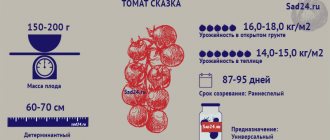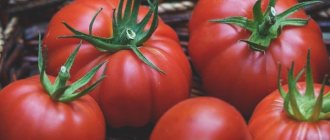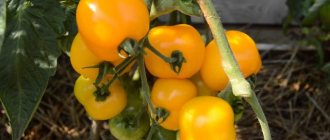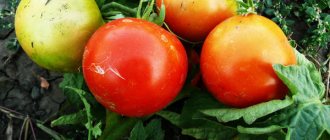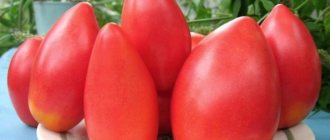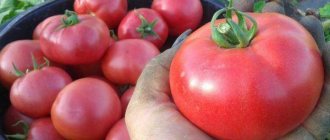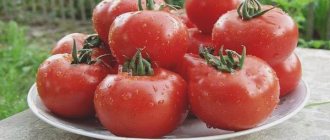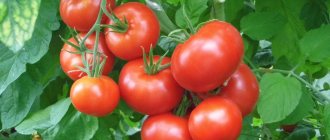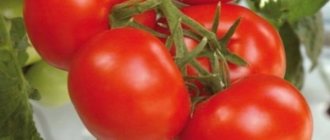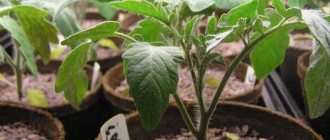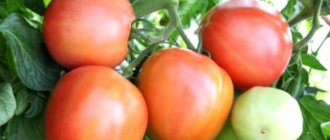The Sprint Timer tomato differs from others in its high yield and giant fruits. It is suitable for open ground and greenhouses. In an open-air garden, the bushes will be smaller and the yield will be lower, but the tomatoes will gain more sugar.
| Height | Landing location | Ripening time | Fruit color | Fruit size | Origin | Fruit shape |
| Tall | Greenhouse, Open ground | Mid-season | Reds | Large | Variety | Flat-round |
general description
The tomato variety Sprint timer is a tall variety. The bush is of indeterminate type, it grows up to 160-250 cm.
The plant is considered mid-season: tomatoes ripen 115-120 days after germination. The fruits are tied in small clusters - 3-5 pieces each.
Fruit
The shape of tomato fruits is heart-shaped or round. The color of the skin and pulp is red. Weight varies from 400 to 800 g, but the weight can be greater (instances of the first harvest even reach 1 kg).
The taste of the fruits of this variety is sweet. The pulp is juicy and fleshy, moderately dense.
Most often they are used for slicing, salads, stewing and baking. They are too large for canning. The harvest can also be processed into juices, ketchups or pastes.
Productivity
Sprint Timer boasts good productivity - 4-5 kg of tomatoes are harvested from one bush.
For the best harvest, it is recommended to form tomatoes into 1-2 stems.
According to the experience of gardeners, when formed into 1 stem, the number of fruits comes out less, but they are much larger.
Sprint timer – tomato up to 2 kg
Super grade
We plant seedlings in open ground after May frosts.
We dig deep holes (50x50 cm), pour into each a bucket of humus, a liter jar of wood ash and add a handful of superphosphate. Mix everything thoroughly, water and plant the plants at a distance of 0.7 m (1 m between rows).
We drive stakes 2.5-3.0 m high into the soil half a meter deep. The trellis must be reliable, since the stem of the bushes is weak and always tends to bend toward the ground.
We form it into one stem, removing all stepsons that have reached 7-10 cm in length. We do not remove flower stalks, since the plants do not need to be normalized.
We tie the stems to the stakes every 30-40 cm. It is not necessary to tie the clusters with fruits, since the stalks are very strong and can withstand a lot of fruit. Ripe fruits can only be cut with pruning shears.
One of the features is that such tomatoes require regular, abundant watering.
Considering that the variety has little resistance to late blight, we regularly treat it with fungicides: Ridomil, Ordan, Tatu.
When the tomato harvest ripens, spray with antifungal Trichopolum (20 tablets per 10 liters of water).
If everything is done correctly, the bushes can grow up to 4 m, and the weight of the fruits will reach 1.5-2 kg. And in each cluster 4-5 large fruits of 800 grams or more will be formed, not counting the “little things” of 300-400 g.
This is not surprising, because among all tall varieties, Sprint-Timer is the recognized leader in yield and large-fruitedness.
Advantages and disadvantages
Based on the description of the Sprint Timer variety, the following advantages of tomatoes can be identified:
- the fruits are large, sweet and beautiful;
- the skin does not crack;
- high yield (up to 5 kg per bush);
- the variety is resistant to diseases;
- The fruits have excellent keeping quality.
The variety has no significant disadvantages. Sometimes he gets late blight, but with the help of prevention this can be avoided. During the rainy season, tomatoes may become more bland and watery.
Landing technology
Tomatoes are recommended to be planted in seedlings. Seeds are sown in early March, and in the first half of May the seedlings are transplanted into a greenhouse.
The seeds are first disinfected in potassium permanganate and germinated in a damp cloth (if desired, they can be treated with a growth regulator).
The turf soil is steamed for disinfection and mixed with peat and mineral fertilizers. The seeds are placed in grooves every 2-3 cm, at a depth of 0.5-1 cm.
The crops are moistened with a spray bottle and covered with polyethylene. Before the first shoots, set the temperature to 24-26°C. After the sprouts appear, the film is removed and the temperature is lowered to 16°C for one week.
Suitable conditions for seedlings
Plants are watered with warm water
The box with seedlings is placed on the windowsill and the temperature is raised to 22-24°C. Young plants are watered with warm water once a week. When 2 true leaves appear, the tomatoes are dived into separate pots. At the same time, the first fertilizing is applied - mineral fertilizers.
():
The first feeding of seedlings is carried out approximately a week after picking, when the plants take root and the roots begin to work.
Tomatoes begin to harden 2 weeks before transplanting into the greenhouse. The pots are taken outside every day, left for 1-2 hours, the hardening time is gradually increased.
Transfer
In the greenhouse, the soil is prepared: compost is added, watered with a manganese solution, and dug up. Install a trellis for gartering tall bushes.
Planting holes are placed at a distance of 50 cm, and the same amount is spaced between rows.
Ash, eggshells, and superphosphate are placed in each hole. Tomatoes are watered generously with warm water, covered with soil and mulched.
():
It is better to use a good organic fertilizer for local application into the holes - humus or mature compost. Egg shells decompose in the soil for about 2 years and do not have any positive effect on seedlings. If handled improperly, ash can cause burns to the root system.
Sprint timer – tomato up to 2 kg
The Sprint-timer tomato is a mid-season variety that stands out for its giant fruits.
It can be grown in greenhouse conditions and in open ground. In the first case, the bushes will grow up to 1.6 m in height. In open ground they will be slightly lower. Such tomatoes need to be tied up and a few stems left. If you properly care for the bushes, you can get large tomatoes. When they ripen they turn a dark red color. They taste sweet, not sour. They are consumed fresh and sauces and juices are prepared from them.
https://www.youtube.com/watch?v=9rdIevofN70
Tomato Sprint Timer will appeal to everyone who loves large and sweet fruits. The variety is not in the official register and is considered an achievement of folk selection. It is usually distributed by private amateur breeders or small agricultural firms. The characteristics of the variety may vary depending on the manufacturers (you need to remember this when purchasing seeds).
general description
The tomato variety Sprint timer is a tall variety. The bush is of indeterminate type, it grows up to 160-250 cm.
The plant is considered mid-season: tomatoes ripen 115-120 days after germination. The fruits are tied in small clusters - 3-5 pieces each.
The shape of tomato fruits is heart-shaped or round. The color of the skin and pulp is red. Weight varies from 400 to 800 g, but the weight can be greater (instances of the first harvest even reach 1 kg).
The taste of the fruits of this variety is sweet. The pulp is juicy and fleshy, moderately dense.
Most often they are used for slicing, salads, stewing and baking. They are too large for canning. The harvest can also be processed into juices, ketchups or pastes.
Productivity
Sprint Timer boasts good productivity - 4-5 kg of tomatoes are harvested from one bush.
According to the experience of gardeners, when formed into 1 stem, the number of fruits comes out less, but they are much larger.
Based on the description of the Sprint Timer variety, the following advantages of tomatoes can be identified:
- the fruits are large, sweet and beautiful;
- the skin does not crack;
- high yield (up to 5 kg per bush);
- the variety is resistant to diseases;
- The fruits have excellent keeping quality.
The variety has no significant disadvantages. Sometimes he gets late blight, but with the help of prevention this can be avoided. During the rainy season, tomatoes may become more bland and watery.
Landing technology
Tomatoes are recommended to be planted in seedlings. Seeds are sown in early March, and in the first half of May the seedlings are transplanted into a greenhouse.
The turf soil is steamed for disinfection and mixed with peat and mineral fertilizers. The seeds are placed in grooves every 2-3 cm, at a depth of 0.5-1 cm.
The crops are moistened with a spray bottle and covered with polyethylene. Before the first shoots, set the temperature to 24-26°C. After the sprouts appear, the film is removed and the temperature is lowered to 16°C for one week.
Plants are watered with warm water
The box with seedlings is placed on the windowsill and the temperature is raised to 22-24°C. Young plants are watered with warm water once a week. When 2 true leaves appear, the tomatoes are dived into separate pots. At the same time, the first fertilizing is applied - mineral fertilizers.
The first feeding of seedlings is carried out approximately a week after picking, when the plants take root and the roots begin to work.
Tomatoes begin to harden 2 weeks before transplanting into the greenhouse. The pots are taken outside every day, left for 1-2 hours, the hardening time is gradually increased.
Transfer
In the greenhouse, the soil is prepared: compost is added, watered with a manganese solution, and dug up. Install a trellis for gartering tall bushes.
Ash, eggshells, and superphosphate are placed in each hole. Tomatoes are watered generously with warm water, covered with soil and mulched.
READ MORE: Why hydrangea leaves have pale leaves - main reasons
It is better to use a good organic fertilizer for local application into the holes - humus or mature compost. Egg shells decompose in the soil for about 2 years and do not have any positive effect on seedlings. If handled improperly, ash can cause burns to the root system.
Subtleties of care
According to the description of the cultivation process, the bushes are formed into 1-2 stems and tied to a trellis. The lower leaves are thinned out, double flowers are picked off.
Double flowers tend to form large-fruited tomato varieties. This phenomenon is called fasciation. This is the fusion of several flowers as a result of external and internal reasons. The result is malformed fruit that stunts growth and robs other fruit of its nutrients.
Watering is done once a week, fertilizing is done once every two weeks. Water the plants strictly at the roots, using 5-6 liters of warm water for each bush (depending on the condition of the soil).
If possible, combine fertilizing with watering, using liquid organic or mineral water-soluble fertilizers. They are applied one at a time to saturate the root system and ensure soil fertility.
- To fertilize with organic matter, use an infusion of manure or bird droppings (1 kg of fertilizer per 2 buckets of water).
- As for mineral fertilizers, a solution of potassium magnesium (1 tsp per 10 l of water) or any complexes like “Solution” (2 tbsp per 10 l of water) is suitable.
After watering, the soil is loosened and the bushes are hilled up. In order not to bother with loosening and weeding, many gardeners mulch their beds with non-woven black material, peat or dry grass.
To avoid late blight, the greenhouse must be ventilated frequently. To prevent diseases, the ground is powdered with ash, and the bushes are watered with a manganese solution. In addition, plants are sprayed with Bordeaux mixture and copper-containing preparations.
According to gardeners, Sprint Timer tomatoes fully correspond to the description. The fruits are large and sweet, do not crack. Most often they are consumed fresh, and the excess is processed. They have good shelf life and can be stored in a cool place for about 2 months.
According to gardeners, the tomato has a long period of fruiting - from the second half of July to late autumn.
The first tomatoes grow the largest, and the next ones become a little smaller. Vegetable growers agree that this variety is well worth the effort spent on growing it.
Tomatoes have long been a sought-after plant in gardeners' garden beds. Sprint tomatoes are popular among Russian vegetable growers due to their taste and resistance to many diseases.
Variety information
The Sprint Timer tomato variety is suitable for cultivation in greenhouses and open ground. General characteristics of the plant:
- Mid-season, the berries begin to ripen 120 days after planting the seeds;
- Indeterminate;
- Tall, the bush reaches 2 meters;
- Large-fruited;
- Resistance to most nightshade diseases;
- Medium foliage;
- The leaves are light green;
- High yield, up to 16 kilograms of berries per square meter of planting;
- Resistance to temperature changes;
- Not prone to cracking;
- Good keeping quality;
- Possibility of transportation over long distances, without loss of presentation.
Tomato is successfully cultivated in the southern regions of Russia and in areas of the temperate climate zone. Technical data and appearance of the fruit:
- Heart-shaped;
- Large size, the weight of one tomato reaches 1 kilogram;
- Fleshy;
- Minimum number of seeds;
- Bright red color;
- Sweet taste;
- Juicy;
- Ribbed;
- Dense;
- Fragrant.
Consumer reviews indicate the good taste of the giant tomato. The ripe berry is suitable for fresh consumption and an ingredient for vegetable salads. Tomato variety Sprint Timer is not used for pickling or canning. The fruits can be processed into tomato products. Tomato juice, ketchup, puree and paste are obtained from the berries.
For the Sprint Timer tomato variety, like most of its relatives, the seedling planting method is preferred. Healthy seedlings are the key to producing large fruits. At the end of winter, preparatory work begins. Rules for preparing seedlings:
- Prepare containers with universal soil for tomatoes;
- Maintain temperature plus 22-25 degrees;
- Seed planting depth is 1.5-2 centimeters;
- Moisten the soil after planting, use a spray bottle;
- Provide the sprouts with daily light for at least 12 hours;
- Regular watering;
- Harden off before planting.
IMPORTANT! After the first leaves appear, it is recommended to pick.
Planting of seedlings is carried out in the month of May. The plant shows the best yield at a low planting density; more than 4 tomatoes should not be placed on one meter of land. When planting, you should follow a 50 x 40 cm pattern. Plant care includes:
- Watering;
- Loosening and weeding of the soil;
- Feeding with complex mineral fertilizer, up to 6 times per season;
- Tying with synthetic material and installing supports.
READ MORE: Tomato Pretty - description and characteristics of the variety
Gardeners' opinion
Good day! This summer I discovered the Sprint Timer variety. The plant turned out to be unpretentious. Loves abundant watering and feeding. When growing in a greenhouse, be sure to ventilate the room well. The berries, subject to agricultural technology, are very large. I managed to grow berries weighing 700 grams. Very tasty and juicy. I recommend!
Katerina Vasilyeva, 45 years old.
Good day to all! For lovers of large-fruited tomatoes, I advise you to try the Sprint Timer variety. The plant tolerates temperature changes well, is unpretentious and resistant to many diseases. The fruits are fleshy and sweet, weighing up to 1 kilogram.
Many people think that growing a large-fruited variety of tomatoes is very difficult - it’s almost “aerobatics.” This is far from true. Having planted Sprint Timer, you just need to tinker a little to get fruits of 1000 grams or more. Moreover, consisting of solid sweet pulp.
At least amateurs cope with this task easily. These are not farm hectares; on your 4-6 acres you can do a little work with these capricious, but very generous tomatoes.
Super grade
There are domestic giant tomato varieties. But you can choose American supergiants. Some of them produce greater yields than other varieties. There is no need to plant a lot of them. 30 bushes are enough to make enough for salads, ketchups, and pastes.
Subtleties of care
According to the description of the cultivation process, the bushes are formed into 1-2 stems and tied to a trellis. The lower leaves are thinned out, double flowers are picked off.
():
Double flowers tend to form large-fruited tomato varieties. This phenomenon is called fasciation. This is the fusion of several flowers as a result of external and internal reasons. The result is malformed fruit that stunts growth and robs other fruit of its nutrients.
Watering is done once a week, fertilizing is done once every two weeks. Water the plants strictly at the roots, using 5-6 liters of warm water for each bush (depending on the condition of the soil).
If possible, combine fertilizing with watering, using liquid organic or mineral water-soluble fertilizers. They are applied one at a time to saturate the root system and ensure soil fertility.
- To fertilize with organic matter, use an infusion of manure or bird droppings (1 kg of fertilizer per 2 buckets of water).
- As for mineral fertilizers, a solution of potassium magnesium (1 tsp per 10 l of water) or any complexes like “Solution” (2 tbsp per 10 l of water) is suitable.
After watering, the soil is loosened and the bushes are hilled up. In order not to bother with loosening and weeding, many gardeners mulch their beds with non-woven black material, peat or dry grass.
To avoid late blight, the greenhouse must be ventilated frequently. To prevent diseases, the ground is powdered with ash, and the bushes are watered with a manganese solution. In addition, plants are sprayed with Bordeaux mixture and copper-containing preparations.
Features of cultivation
The following are the advantages and features of Sprint-timer tomatoes:
- They are resistant to temperature fluctuations and stable in yield.
- Tomatoes have a marketable appearance, so they are often planted for further sale.
- Fruits ripen in 120 days
- The variety is resistant to diseases
- Fruits are universal, as they are used for different purposes.
- The tomatoes are very tasty
Sprint-timer tomatoes are grown according to the general rules that apply to other varieties of tomatoes. Initially, you need to plant the seeds for seedlings. Before planting, they need to be prepared. Soaking is carried out in an ash solution for 6 hours. For this solution, 1 liter of water is mixed with 1 tbsp. l. wood ash. During the soaking period, the seed material will swell and nutrients will be absorbed.
After such manipulation, it is necessary to disinfect the seeds. They are placed for a third of an hour in a solution of potassium permanganate. After this, they are washed and placed in a bag in the refrigerator for three days. This is how hardening will occur. The soil for planting seeds must be taken from the garden where cucumbers or cabbage were grown. But the soil on which onions, potatoes or peppers grew will not work.
READ MORE: Rose Arthur Bell: description and cultivation
To avoid contamination by microorganisms, it is worth disinfecting containers. Seeds are planted at the end of winter. The temperature where the container will stand should be 22-24 degrees. When shoots are visible, the boxes are moved to a cooler place. When the outside temperature reaches 10-12 degrees, then you can begin hardening the seedlings. First, it is taken out for an hour, then this time is increased daily.
Some owners think that picking is a useless procedure. But others willingly do it to make the plant hardy and strong. But experienced gardeners advise picking tomatoes. This leads to the fact that the plant begins to develop better, which increases the future harvest.
Planting seedlings in open ground is carried out in May, when the soil has warmed up sufficiently. Planted plants do not need to be covered. They are only allowed to be shaded from the sun. Humus must be added to each hole. Experienced gardeners advise deepening the 2 lower stems into the ground during planting. Many people have heard that when replanting, a plant can lose hairs on its roots. In addition, it is difficult for him to endure such a procedure.
Experienced gardeners advise adhering to the following rules:
- In order for the soil ball to be large, it is worth watering it well a couple of hours before the intended planting of the seedlings.
- When you take a plant out of a box, you need to try to grab as much land as possible. To avoid damaging the seedlings, you need to grasp them well with your hands.
- It is recommended to plant in cloudy weather or during rains.
- If it is sunny outside, then you should do this procedure in the evening.
- After planting, the plants must be regularly watered, loosened the soil, removed weeds, and applied mineral fertilizers to the soil.
This variety, like many others, can suffer from late blight. For this purpose, it is recommended to treat with fungicides. The main rule: to get a good harvest, you need to water your tomatoes well.
Gardeners' opinion about the variety
According to gardeners, Sprint Timer tomatoes fully correspond to the description. The fruits are large and sweet, do not crack. Most often they are consumed fresh, and the excess is processed. They have good shelf life and can be stored in a cool place for about 2 months.
According to gardeners, the tomato has a long period of fruiting - from the second half of July to late autumn.
The first tomatoes grow the largest, and the next ones become a little smaller. Vegetable growers agree that this variety is well worth the effort spent on growing it.
Review of Tomato Sprint Timer
Timer sprint for meat! / Tomato with almost no seeds!
Yield seeds of giant tomatoes. (best varieties of tomatoes)
Tomato without seedlings: varieties, cultivation, care
Some varieties of tomatoes can be grown without the use of seedlings.
There are many ways to grow these tomatoes. Growing full-fledged seedlings is not easy, so amateur gardeners often buy them at the market, which usually poses some risk of not getting enough quality or the right variety. The way out of this situation is a seedless method of growing tomatoes. Tomato seeds are sown directly into the ground where they grow continuously. It should be borne in mind that this method can allow tomatoes to be grown both in southern regions and in cooler climates. So, how to grow tomatoes without seedlings?
Do you think that the seedless method of growing is better than other methods?
Features of seedless tomatoes
Tomatoes can have two types of bushes:
- High (undefined). Unspecified varieties may have significant stem height. A flower raceme is formed at the end of the main stem. Stepchildren located in close proximity to the main trunk do not stop their growth. This process continues throughout the growing season, but stops only with the onset of cold autumn days.
The height of such tomato bushes can reach more than 2 meters. However, as a rule, the intensity of the appearance of fruiting clusters and ovaries is much less than in the case of small-growing tomatoes.
- Low (determinants). In low varieties, there is a peculiarity of growing no more than 1 meter. Its bushes have from 3 to 6 main and lateral stems, and stepsons, as a rule, are formed on the lower part.
The description of tomatoes includes the fact that they prefer heat:
- If the temperature drops to 10 degrees, pollen does not have the opportunity to ripen, and the ovaries remain without fertilization and fall off.
- Optimal for growing tomatoes, temperature is from +21 to +25 degrees. Although plants love moisture, its excess can negatively affect the growth of bushes and the ripening of fruits.
- The need for luminous flux is of great importance. If this is not enough, the plants become elongated and the roots develop poorly.
Non-seedling tomatoes prefer light soil with high nutrient content, but can also grow in other soils. The only exceptions are those that are very sour or too salty.
Non-seedling varieties of tomatoes
Varieties of seedless tomatoes:
- Frost-resistant varieties of P. Ya. Saraeva, for example, Stoiky - standard, 40 cm, fruits weighing 50-100 g.
- Canned, bush and determinate large-sized (150-300 g) varieties:
- Ground;
- May;
- June;
- Siberian;
- Spring frosts;
- Orenburg resident;
- Pink.
Sub-Arctic 2 - seedless, frost-resistant, can withstand down to -5 degrees, the fruit is dense, weighing 100-200 g, the fruit is stretched, productivity is 1-2 buckets per bush, depending on the duration of the growing season.
- Variety of tomatoes Vittas (hybrid of Subarctic 2 with Raspberry King) - shrub 1.5 m, fruits are dense, sweet, weighing up to 300 g, do not shoot. And the largest (fruits up to 1 kg) from frost-resistant varieties are Wild Rose.
Growing tomatoes in open ground
Let's consider a seedless method of growing tomatoes in open ground, where determinate varieties of this vegetable are used (early varieties of tomatoes), which are not afraid of compact planting in close proximity to each other:
- Then the holes can be placed in a checkerboard pattern at a distance of 30 centimeters.
- The main thing in the future is to create good ventilation, remove unnecessary leaves and, if necessary, intervene in the actions of the stepsons.
- Before sowing seeds, it is necessary to fill the soil with well-heated water and preferably with a hot solution of potassium permanganate.
- In each hole, no more than 5 seeds are placed in a circle, covered with a 1.5 cm layer of soil and watered with warm water.
- After this, a glass jar or a cut plastic bottle is placed in front of each hole with planting material.
- Everything is covered from above with the prepared material, and the plastic film is stretched over equipped arches, which are pressed against the soil from all sides.
How to grow tomatoes in a greenhouse
How to grow tomatoes without seedlings? Arcs are used to tension the coating. Before installing them, the beds are dug up and compost or humus is added. To insulate the ridges, it would be good to make wooden boards along the edges. The beds are made in the same way in the greenhouse. Here you can warm the beds from the inside with a layer of manure.
The manure should not be completely fresh and covered with a sufficient layer of soil so as not to burn the roots of the plants.
Before you start preparing the ground for tomato planting, be sure to pour hot water over the selected area. It is good to add manganese for disinfection.
Then, do not forget to maintain the time and planting scheme for tomatoes:
- Sowing is carried out at the end of April (if the weather is favorable) and until mid-May.
- The nesting method has proven itself well, in which up to 5 seeds are sown in one hole. This allows you to leave the strongest seedling in the future.
- It looks strong, the leaves are dark green, the internodes are short, the root is deep in the ground.
So, in order to grow a good crop of tomatoes in a greenhouse, you will need to do the following:
- thin out seedlings;
- mulch the holes with compost;
- pinch out the stepsons after two weeks to maintain their single-stem shape;
- remove growing points after creating 3-4 brushes for pouring fruit;
- remove the fruits from the lower cluster unripe for further ripening;
- remove lower leaves and shoots using pruning shears;
- get a good harvest from the top clusters.
Growing tomatoes without seedlings is practiced both in open ground and in a greenhouse. The second option is very successful:
- During a long spring. A tomato grown in a greenhouse is reliably protected, especially when the owner is away from the site.
- In addition, before warming, it is convenient to grow tomatoes in a greenhouse and then transplant them into open ground. Tomatoes should not be tall and spreading, so it is important to pay attention to the choice of variety.
- Bushes grown in greenhouses are planted in open ground and first covered with non-woven material. This will speed up the period of fruit ripening and protect the tomatoes from the vagaries of the weather.
Care
Before the first shoots appear, it is better not to touch the beds. After the tomato seeds germinate, the seedlings need to be opened, depending on the weather conditions - if it is warm and sunny outside, then the seedlings will fully open, if it is cloudy and cool, then it is better not to disturb the tomato seedlings.
After 90% of the seeds have germinated, one of the best two bushes remains in the hole, and the rest are either replanted or simply pulled out depending on the needs of the gardener, and also you need to know:
- That such tomatoes need to be watered less than usual. This is due to the fact that they are not picked and replanted, so the root system is not disturbed.
- The central part of the root is maximally strengthened, and the lateral shoots are more developed.
- Therefore, the plants themselves are able to provide the required amount of moisture, and watering is carried out only during prolonged drought.
You can also watch a video where an experienced gardener will tell you how to plant tomatoes using the seedless method.
Growing tomatoes without seedlings is a valuable experience and an exciting process. Choose your “own” varieties, experiment with beds and shelter. Your work will definitely be rewarded.
Source: https://prodachnika.com/ogorod/tomaty/bezrassadnyj.html
